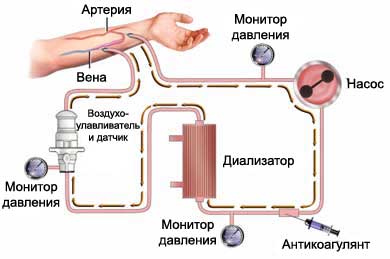Hemodialysis – Dialysis
Description dialysis
Dialysis – treatment, which takes over the job of the kidneys, if they cease to function properly. The kidneys perform many functions, that help the body stay healthy. They help to remove toxins from the blood and restore the normal level of salt balance. Most dialysis patients prescribed, when the kidneys lose 85%-90% function. Dialysis may be performed for a short time, or the need to spend the rest of his life (or until a kidney transplant performed), depending on the cause of kidney disease.
If the kidneys are not working and the damage is not reversible, then you have developed chronic renal failure (CRF). CKD is caused by various diseases, such as diabetes, kidney cancer, drug use, high blood pressure, or other problems with kidney. Dialysis is not a cure for CRF, but it will help you feel better and live longer.
There are two types of dialysis: hemodialysis and pyeritonyealinyi dialysis. The following describes a method of dialysis.
Reasons for hemodialysis
The main objectives of hemodialysis:
- Removing waste and excess fluid from the blood;
- Control blood pressure;
- Maintaining a safe level of certain salts and elements in the body – potassium, and sodium chloride.
Dialysis can be performed, to quickly remove toxins from the blood. It can also be used in the event of poisoning or drug overdose.
Possible complications of hemodialysis
Complications are rare, but no procedure does not guarantee the absence of risk. Before, how to perform dialysis, you need to know about possible complications, which may include:
- Lowering the number of erythrocytes, causing anemia;
- The fall in blood pressure during dialysis;
- Muscle cramps;
- Nausea, vomiting;
- Headache;
- Infection;
- Feeling the heat, Sweating, weakness and / or dizziness;
- Inflammation of the heart sac (perikardit);
- Neurological problems;
- An imbalance of calcium and phosphorus, which leads to weakening of the bones.
Besides, the presence of heart disease is one of the factors, which can increase the risk of complications from hemodialysis.
As hemodialysis?
Preparation for the procedure
Usually, before the first hemodialysis in a large vein tube inserted, to facilitate blood flow from the body to the dialysis machine and vice versa. If you will be on hemodialysis for a long time, perhaps, operation will be made to create a shunt or fistula, which will facilitate access to a large vein. Fistulas, perhaps, It needs about 2-3 months, to fully heal, before it can be used. If the treatment is temporary, fistula are not made. Usually, they are a few months before the start of hemodialysis.
Other procedures, are performed before hemodialysis:
- They will be measured by weight, blood pressure and temperature;
- Mestnый anesthetic – usually used if necessary to the introduction of a needle;
- Heparin – It is given to prevent blood clotting.
Anesthesia
Before the procedure is given a local anesthetic.
Description hemodialysis
Hemodialysis is performed in a dialysis center or hospital. Sometimes it can be performed at home, in providing assistance.
During the procedure, blood is filtered through the machine “artificial kidney” – dialyzer. Blood comes from the body into the car through the tube, which is inserted into the large vein. After, It filter the blood in the machine, she goes through another tube back into the body.

How long does hemodialysis?
Hemodialysis usually performed three times per week. Each procedure can last 2-4 o'clock. Current time of the procedure depends on several factors:
- Functionality of kidneys;
- Increasing the amount of liquid since the previous procedure;
- The amount of waste in the body;
- Body size;
- The level of salts in the body, salts such as sodium, potassium chloride.
Will patients with hemodialysis?
Generally, hemodialysis does not cause pain. You will not feel that well, the blood flows through a different path. There may be some temporary discomfort with the insertion of the needle or tube.
Care after hemodialysis
Care in a hospital
Will control blood pressure. After the procedure, If blood pressure is stable, you can continue daily activities.
Home Care
Be sure to follow your doctor's instructions. There are some features of care after hemodialysis:
Diet
Must be complied with some advice on nutrition. This will help to maintain overall health and increase the effectiveness of treatment. Talk to your doctor for specific recommendations.
Medications
Your doctor may prescribe different medications reception. They include the following formulations (The list can be extended):
- Medications to control blood pressure;
- Calcium supplements or multivitamins;
- Fosforosvyazuyuschie, to reduce phosphorus levels in the blood;
- Diuretics, to remove excess fluid;
- Laxatives, for preventing or treating constipation, which may be caused by a decrease in fluid intake;
- Iron preparations – Iron is very important for production of red blood cells;
- Drugs, to stimulate the body to produce more red blood cells.
Contact your doctor after hemodialysis
After returning home, you need to see a doctor, If the following symptoms:
- Signs of infection, including fever and chills;
- Redness, edema, heat, pain, bleeding, or discharge at the site of the catheter or tube;
- Nausea and vomiting;
- Dol in vivo;
- Dizziness and weakness.
